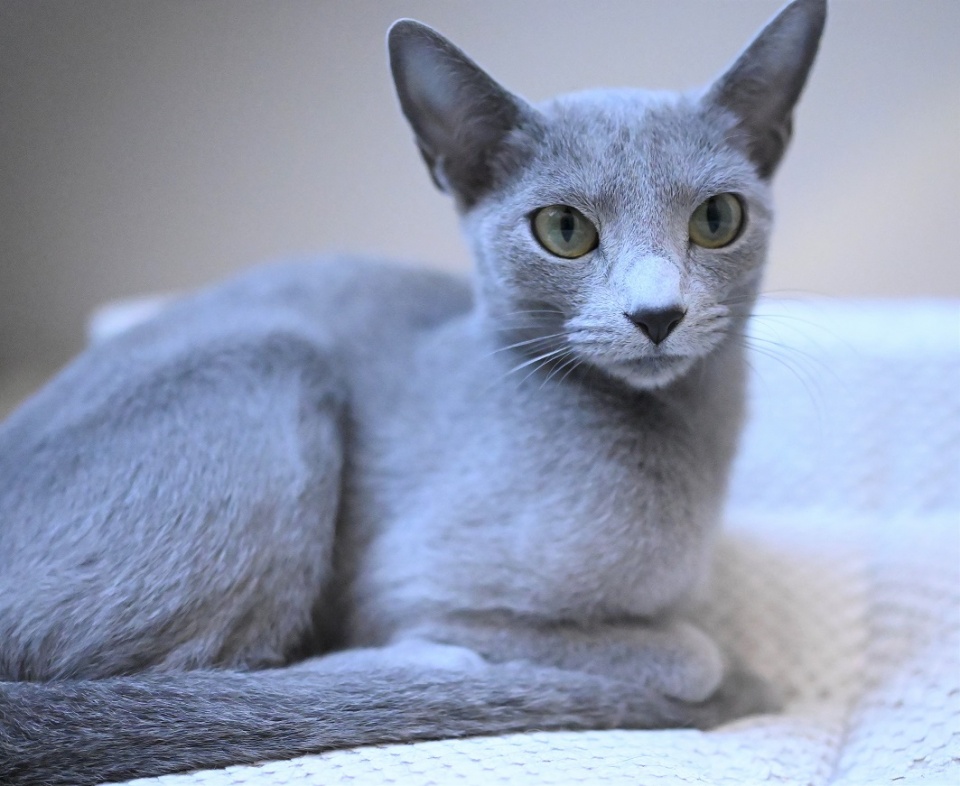
Physical Characteristics
The Russian Blue Cats are strong breed with strong muscles and good looks all around. It looks like the Korat and the Oriental Shorthair because it is long, thin, and elegant. It is about the same size as a human and has muscles, but they are packed together like a swimmer’s. When the cat is moving and stretched out, you can see that it has a long, graceful neck. However, when the cat is sitting, its thick fur and high shoulder blades hide its neck, making it look like it has a short, thick neck. The Russian Blue’s double coat, which is the most striking thing about this breed, makes it look bigger than it is.
The hair sticks out at a 45-degree angle, which lets you draw patterns into it that will stay there until you smooth your hand over them. Some stories say that hunters once went after the Russian Blue because their fur was so soft and looked like seal fur. The base of the coat is bright blue, preferably lavender. It gets darker as it goes up the shaft and gets silver at the tips of the guard hairs, which protect the top coat. The coat sparkles because it reflects light.
The color of this breed’s eyes is one of its most beautiful features. When the Russian Blue is a kitten, its eyes are yellow, but by the time it is four months old, there is a bright green ring around the pupil. As the cat gets older, its eyes change from blue to a bright, vivid green. This makes the cat’s already beautiful blue-silver color even more striking. The Russian Blue’s eyes are big, round, and only a little bit slanted at the top corners. This gives it a sweet look that goes well with its calm personality.
The Russian Blue’s “smile” is one of the most interesting and funny things about it. People often compare its slightly upturned mouth to the mysterious smile of the Mona Lisa.
Personality and Temperament
This cat knows how to behave and is easy to train. Or, it’s easy to teach its people. It likes to play fetch and will keep going even if you don’t have time. You will make time, though, because the Russian Blue is known for looking hurt when it has been ignored. This cat is very elegant and shy, but it is also very playful and loves to chase toys and sunbeams.
The Russian Blue can entertain itself for hours, and it doesn’t mind too much if you leave it home alone all day. However, it will be very happy to see you when you come home. This cat is a great pet because it always follows its owners around and usually likes one person in the family more than the others. It should also be said that the Russian Blue gets along with most people, even kids. They love being around people so much that they will act like clowns to make a crying baby stop crying and pat the face of a sad person when they have the blues.
One weakness of the Blue Russian is that it tends to be easily startled. They are also more likely to be shy and nervous around new people and in strange places. Some people say that this breed was once the target of fur hunters. If this is true, it would explain why they are cautious and move quickly. They would have had to move quickly at the first sound of trouble to keep their lives.
This breed doesn’t like change and would rather have things stay the same and predictable. It can be thrown off if the time for dinner changes, and it is very picky about cleanliness. If the litter box is dirty, it won’t even go in it. Early on, this breed got a bad name at dog shows for being hard to work with because of things like these. At home, the Russian Blue was calm and happy, but at shows, it was grumpy and unhappy. Fewer Russian Blues were shown, and the breed’s popularity fell, until breeders worked to improve the breed’s attitudes through selective breeding and behavior management (e.g., soft music, recording of show noises, crystals, herbal remedies). This dedication to the breed paid off, and now the Russian Blue enjoys going to cat shows.
Health and Care
The Russian Blue doesn’t have any specific health problems. It is a healthy breed, mostly because it is a breed that has always existed. Brushing the coat isn’t necessary, but it’s a nice thing to do once a week in addition to things like brushing the teeth. This breed really enjoys being around people and will sit still while being combed or brushed because it gets to spend time with the person who cares for it.
One important thing to remember about this breed is that it loves food. If it can eat as much as it wants, it will eat more than it needs and ask for more, which makes it a sure candidate for weight-related health problems. The best way to stop this from happening is to measure the food and only give it to the cat at certain times of the day. Everyone in the house should also know that they can’t give the cat too many treats or scraps.
